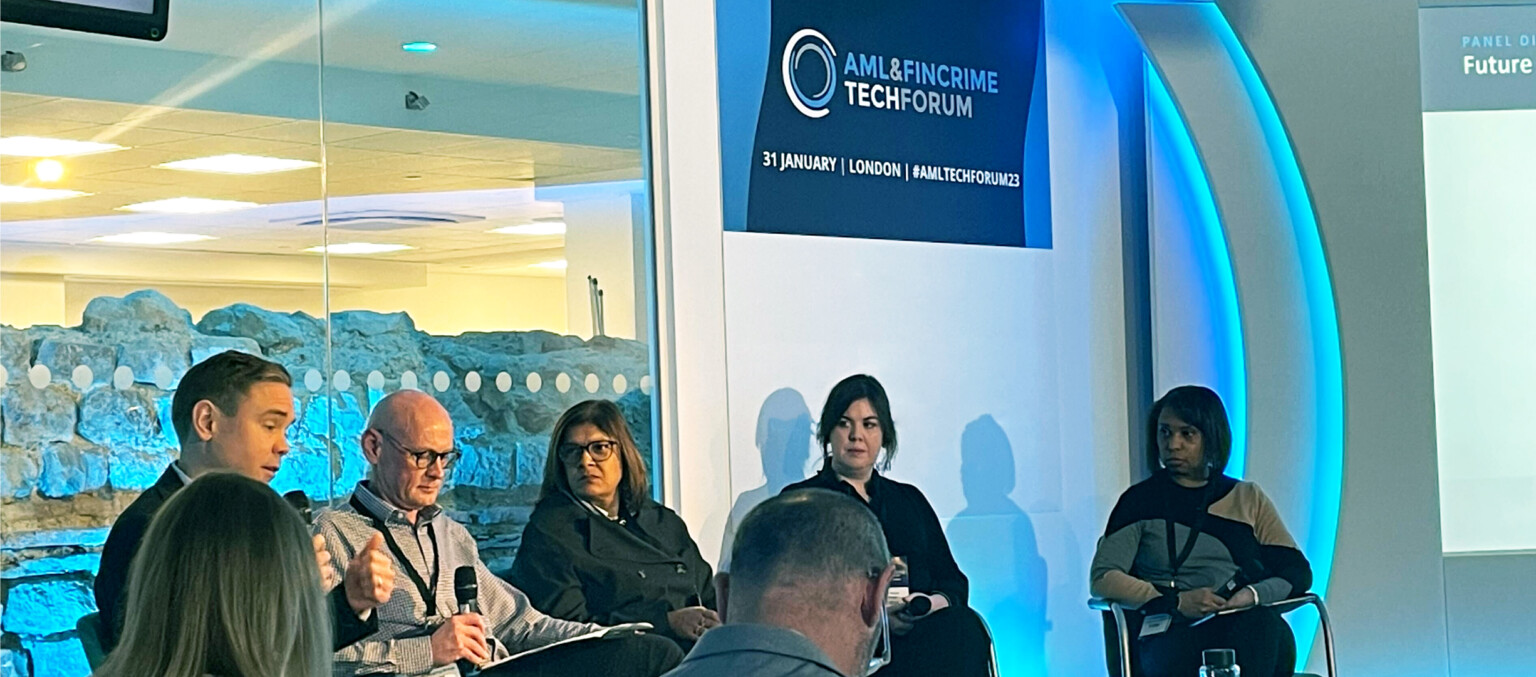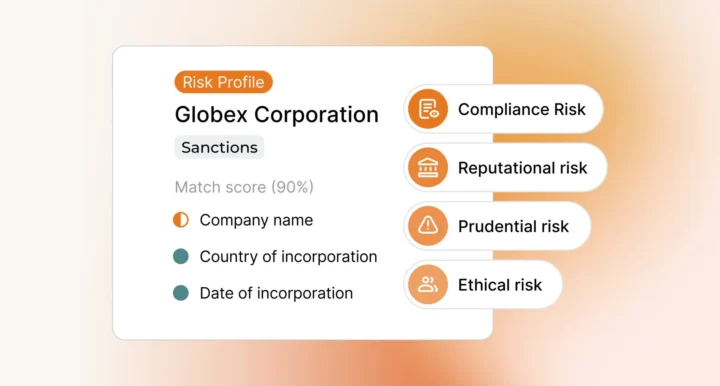The AML & FinCrime Tech Forum took place in January 2023, bringing together leaders, experts, and innovators from across the data science, fintech, and anti-money laundering (AML) and counter-financing of terrorism (CFT) communities. The Forum focused on the latest strategies to combat financial crime, with debates, presentations, and demonstrations of fintech and regtech innovations.
Ripjar’s Chief Product Officer, Gabriel Hopkins, attended the event to lend his professional expertise to the panel discussion: Future FinCrime and the Pain Points Within Your Organisation. The panel included speakers from banks and fintech organisations, who discussed the most dangerous emerging criminal methodologies, how they impact and harm both customers and institutions, and how technology can help address the threats. Moderator Howard Rawstron, Head of Economic Crime Prevention Oversight at Lloyds Banking Group, acknowledged that many of the topics involved potential future scenarios, but that the panel’s pedigree would ensure that the debate benefitted from a depth of industry experience.
Let’s take a closer look at some of the key questions and points from the discussion.
What are the biggest emerging financial crime threats to both customers and institutions?
The panel opened by examining the significant challenges that institutions face in keeping pace with the sophistication of financial criminals. Susan Symes, UK Head of Investigations at Fidelity International, pointed out that criminals increasingly exploit technology to use their victims to support the fraud they are committing – using push payments for example to get customers themselves to initiate fraudulent payments unwittingly, and so make it harder for firms to detect the presence of bad actors. Symes added that, in many cases, customers are unaware that they are victims of fraud: criminals may imitate certain brands or products to disguise fraud, or use the pretext of a maturing payment that offers returns down the line to keep victims unaware of the fraud until months later.
Renitha Singh, Group Financial Crime Compliance Officer at Liberty Holdings, raised the prospect of “state capture” as a significant financial crime threat. Singh used the example of the infiltration of the South African government by a criminal organisation to illustrate the potential for organised crime groups to extract huge amounts of money from corrupt or vulnerable state entities.
Ripjar’s Gabriel Hopkins echoed those sentiments, pointing out that financial crime, and specifically fraud, had undergone a change in recent years: from something that happened to people, to something that people did to themselves. Hopkins suggested that shift had made it much more difficult for banks to stay ahead of financial criminals.
How should institutions balance customer controls with customer experiences?
The ongoing challenge of financial crime compliance is to implement AML/CFT controls that are robust enough to detect criminals and fulfil regulatory obligations, without making a firm’s products and services too onerous for customers to use.
The panellists cited the careful integration of technology as a significant advantage in addressing this issue. Fenergo VP of Product Marketing Aoife Doyle suggested that the front-end experiences of customers were less of a problem; with a lot of effort put into the technical quality of the front-end, customers generally receive seamless (and pleasing) experiences when interacting with websites directly. Doyle went on to contrast those experiences with the back-end process, during which firms are required to “scramble” to retrieve data from multiple systems in order to fulfil regulatory requirements, creating significant administrative friction and slowdown in the ultimate delivery of services.
Susan Symes focused on the specific risks of balancing experiences with compliance, pointing out that the dynamic plays into the hands of criminals who may offer expedited services as a way to extract money and data from frustrated customers. Symes emphasised that “disruption” was the key to tackling fraud: the more obstacles fraudsters face when attempting to gain customers’ confidence, the more likely their efforts are to fail. On the notion of AML/CFT controls versus customer experiences, Symes stated that it was always “easier to sleep” knowing that customers were frustrated, than having handed their details to criminals.
Acknowledging those ethical and regulatory concerns, Gabriel Hopkins noted that artificial intelligence (AI) and machine learning tools nonetheless represent a “transformational” asset in the battle to deliver positive customer experiences by giving firms the power to “make strong decisions for their customers, very very quickly”.
How should firms handle the threat of ultimate beneficial ownership?
Where criminals use corporate infrastructure to conceal their identities, electronic identity verification takes on a new importance. Aoife Doyle suggested that firms should seek to leverage a rules-based approach to establishing ultimate beneficial ownership (UBO) – especially in jurisdictions where the threshold for beneficial ownership may refer to individuals with ownership of 10% or even 2% of a given company.
Doyle also suggests that firms must be prepared to work hard to establish UBO, including exploring opportunities to re-use established data to inform compliance decisions. Notably, the complexity of the UBO challenge requires firms to go beyond tech solutions and factor in skilled human intelligence for those instances where compliance efforts need to go deeper than tech-derived identity verification.
In an industry facing a shortage, what skills are needed for economic crime prevention?
While acknowledging the power of employee talent and intelligence in compliance investigations, the panel agreed that it was difficult to overstate the utility of technology, and important not to over-rely on human intuition. Renitha Singh brought both a regulator and commercial perspective to the question, pointing out that compliance technology enables even untrained employees to identify suspicious activity and intervene to prevent potentially serious financial crimes.
Emphasising the “amazing” accomplishments of fintech, Gabriel Hopkins stressed there was an ongoing important role for humans in financial crime processes. Referencing the critical “sixth sense” that top fraud analysts have for spotting criminal activity, he suggested that it was probably “a little too soon” for the eradication of human roles, particularly within fincrime compliance where there are factors which still limit automated decision making. However, Hopkins also pointed out that technology innovation is a constant, and that a number of new, exciting innovations, such as ChatGPT generative AI, are likely to have a big impact in the near future. Hopkins stressed the need to manage the hype around new technology: for example, while ChatGPT has undeniable potential, it exhibits a number of flaws in its current form which limit its use in fraud and financial crime prevention.
How can collaborations help tackle financial crime?
Where government institutions lack the resources to tackle financial crime effectively, or (like the South African government) are compromised by bad actors, collaboration with private entities can be an effective AML/CFT strategy. Renitha Singh referenced the collaborative success of the South African Money Laundering Integrated Task Force (SAMLIT), a think tank that combines public and private resources in a joint effort to assist in prosecutions. Singh pointed out that the value of public-private collaborations lies in their potential to share data and to work operationally – as opposed to the often-ineffectual “gestures” of governments.
In agreement, Gabriel Hopkins added that all collaboration initiatives must be backed by strong security to ensure the safety of public information, and by the political will to effect real change.
How are different demographics affected by financial crime?
In a constantly changing financial landscape, criminal threats can vary significantly by demographic. Susan Symes set out the variety of strategies that criminals use to approach customers, including targeting the users of certain apps or the viewers of certain adverts, or compromising personal devices such as mobile phones. Demographic threats are not fixed, and may change by age, wealth, time of year, and so on. With no one-size-fits-all solution, firms must think about the specific vulnerabilities of their customer groups, and be prepared to continually assess the countermeasures they deploy to prevent crimes.
What can firms do to improve the financial crime detection and investigation process?
The panel emphasised the need to prioritise data in any AML/CFT solution in order to optimise outcomes. While finding and stopping criminal activity directly is obviously a priority, Gabriel Hopkins stressed the need to use customer data contextually as a way to discern changes in behavioural patterns – a strategy that has proved to be effective in almost all levels of technology deployment.
Getting the most out of disparate, dispersed data is key to the investigative process – and with this objective in mind, Hopkins also suggested that firms take steps to make their data as accessible and comprehensible as possible, including introducing a knowledgebase framework and integrating AI-enabled tools. Ripjar’s Labyrinth Screening platform, for example, is built for exactly that purpose, with cutting-edge AI and machine learning technology giving firms the power to identify high risk customers as quickly as possible and make better compliance decisions.
Discover Labyrinth Screening Advantages
In a complex risk landscape, Labyrinth Screening searches thousands of global data sources across different languages, including watchlists, sanctions lists, and news stories, delivering actionable intelligence in seconds while minimising noise and false positives. Labyrinth also gives firms the ability to tailor searches for the most relevant AML/CFT data, building more accurate, more useful risk profiles for each customer.
To learn more about how Ripjar can manage AML/CFT pain points, get in touch today.
Last updated: 3 February 2025





